You’re Still a Kidder, Steve: Michael Napadano Looks Back on Harvester at 26

When it finally debuted in 1996 after years of hype, Harvester didn’t so much come onto the gaming scene with a bang but with a whimper. The brainchild of writer/director Gilbert P. Austin, Harvester had been promoted in magazines and at conventions as the most violent and disturbing video game ever made, a heady boast in the era that gave us such gore-soaked, unsettling classics as Doom, Mortal Kombat, and Clock Tower. An eerie trailer mixing live-action and animation teased audiences with a surrealistic journey into a nightmarish, Stepford-esque Middle American town hiding dark secrets beneath its veneer of hospitability; stills published in magazines veered in the opposite direction, showing off the most gruesome bits of gameplay audiences could expect, including blood-splattered children and grinning, bat-wielding schoolteachers.
As it turned out, though, the pre-release excitement wasn’t just intended to stoke interest but also to buy time; with an already limited budget spiraling out of the control and a minimal production team attempting to tackle a project more ambitious than their resources, the game’s production history became notoriously troubled, leading to multiple delays. What was meant to be a controversy-generating, zeitgeist capturing title instead debuted to disinterested audiences and lackluster sales, with players finding the graphics and mechanics already dated; too, while in 1994 the violence in videogames debate was still a hot button issue, by ’96 that particular sociocultural moment had temporarily passed, not to become a topic of debate again until the broader examination of violent media that came about in the wake of the Columbine Massacre. The game fared better overseas, where, to the delight of its programmers, it was occasionally banned; but for all intents and purposes, Harvester—unlike any of its characters—died a quiet death, relegated to cult status and the crowded bin of videogame history.

That is a damn shame; because, beyond the heinous violence and ghoulish imagery on display, Harvester is a genuine narrative masterpiece, the rare videogame that places storytelling, characterization, and ambiance front and center, delivering an experience just as unsettling and rewarding as the best horror cinema. Set over the course of one week in 1953, the game finds players taking on the role of Steve Mason, an eighteen-year-old boy who awakens one day in the isolated rural town of Harvest, where he’s informed that he’s soon to be wed to his childhood sweetheart, Stephanie. The problem is that Steve has no memory of who he is, no recognition of his family, and vague memories indicating that he may not only be out of place in Harvest but out of time. Directed to seek answers from the Order of the Harvest Moon, a cult-like organization that seemingly functions as Harvest’s governing body, Steve finds himself pressed into performing a series of seemingly banal tasks that have increasingly violent and tragic circumstances. As his wedding date approaches, Steve finds his own sanity slipping as he begins to learn the horrifying secrets behind the town and his presence there.
Despite its reputation—and intentional reliance—on heinous amounts of gore, Harvester’s biggest and best scares come from the measured use of uncanniness in its storytelling and characterization, with subtle, more cerebral scares interwoven with the bloodshed: Steve’s little brother compulsively watches a seemingly endless cowboy program with no apparent plot beyond Videodrome-esque set pieces of ultra-realistic violence; a theater green room with a prominent cigarette machine and movie stills of glamorous smoking scenes plays host to a charred-up abomination; an elderly woman squatting in an abandoned house waxes poetic and erotic about the behavior of the thousands of wasps inhabiting the building. With its emphasis on getting under the player’s skin- and inside their head- Harvester has aged well not only as a game but a piece of horror art, and with the game’s ultimate thesis—an exploration of the relationship between the public and violent media—it’s as relevant today as it was two decades ago. Thankfully, journalist and Vlogger Arno Malin has been keeping the flame alive and spreading the word with The Harvester Show, a combination Facebook page and YouTube show in which he takes a deep-dive exploration into the world and making of the game, often with the help of the programmers and developers who made it happen. It was with Aarno’s kind assistance that I made the acquaintance of Michael Napadano, one of the artists and driving forces behind the game along with Austin. Michael was kind enough to share his memories, experiences, and give a peek behind the curtain of the game we got and the game that could have been…
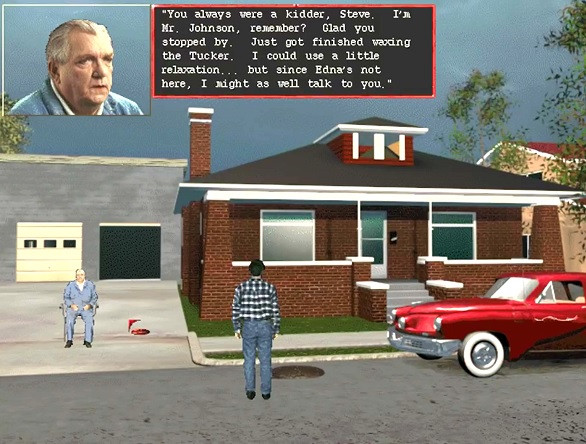
DreadXP: How did you get involved with the project?
Napadano: I was a dog groomer. I started in 1982, 1980; I’d played around with the Commodore 64, played the Ultima games on it, I was in my early 20s and I’m an artist- I’ve been painting with oil paints and sculpting all my life. But I was grooming dogs to make money, and I had a big clientele. This was in Plano, Texas. I was interested in the Amiga because you can really do art on the Amiga, it had great graphics, so I got one, and there was this place called Floppy Joe’s in Plano where you rented video games. There was a guy who worked there named Tom Lima who had a friend, Chad Woyewedzic, and a friend, Nick Shaffner. We all loved the Amiga so much. Nick was a programmer, he programmed on personal computers, and he was only fourteen or fifteen. He was the youngest of us.
We decided to make a video game. We wanted to make a computer game that we would like to play. Since Chad was an artist and had an Amiga, and Nick had an Amiga, and I had one, we set out to start making this game. We got ahold of the guy Tom had worked for, Lee Jacobson, who did kiosk work—graphics for computer kiosks. They were based in a bank building in Richardson. Lee would fund the thing and become somewhat of the controller of it. So, we made the game, it was called Command Adventures: STARSHIP. It was a top-down scroller. The graphics were intense for its time, but, still, it was a top down scroller. It sold 22,000 copies in its first week, so we kinda got big heads. We got in touch with the writer of some of the Ultima series, Gilbert Austin, who was based in Austin, and for our next game he pitched us Harvester. And that’s how it began.
DreadXP: When did you begin work on it? There’s a lot of conflicting information about the game’s production process.
Napadano: We started work on it in late 1990, early 1991. I had just gotten married- to the woman who plays the Dark Woman in the Lodge! It’s hard to say what the development time on it was because we were so off-and-on at the beginning. Gilbert would come into town and stay in a hotel for three nights before going back to Austin and drawing up more stuff. We were working on designing characters, and then also fixing certain things on the first game, things that had gone wrong, so there was some overlap. I think we actually got started laying down the actual computer graphics and starting to put them in around 93-ish. It’s really hard to say looking back at that time period, but it took a while. By the time game testing came around it was a nightmare for all of us because it was so many intricate things that would come together and lock up, if you get this instead of that first, then a whole catastrophe would happen, and we’d have to find out where that problem was. It was a long time. I can say that much! I can’t give you an exact date but the production time took around three years.
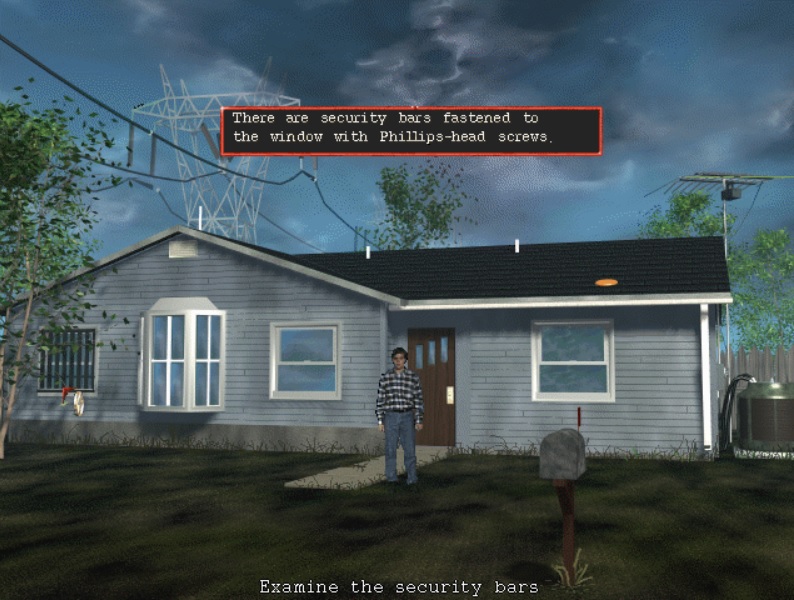
DreadXP: There’s a trailer floating around out there where the characters are computer-animated instead of FMV. Can you tell us about that?
Napadano: I know what you’re talking about! The original demo. Those were drawings I did! I’d move like one or two frames for the eyes. It was very poor quality. [Laughs] That was pitched to us by Lee. “Can you do some cool graphics? It doesn’t have to be what the game will look like but can you put together some stuff that we can put into a little scenario that looks like a trailer?” So I basically just took characters that I liked—Shelly the Waitress from Twin Peaks, that’s who I wanted Stephanie, his love interest, to look like. So for the demo, that was her, I drew a picture of Madchen Amick. Gilbert, the writer, was a Twin Peaks fanatic. And there was a movie around that time called Matinee that had John Goodman in it, and, that was one of the criteria for working there. When we brought in Tim- who plays the evil chess player- that was a requirement, he had to like the movie Matinee and Twin Peaks in order to work for our company. That was Gilbert’s joke requirement. But we used to have weekly meetings and I remember in the staff room, sitting there under dull fluorescent lights looking down at the page and all these words, and all I wanted to do was get started on the graphics. But I had to sit through this little powwow we used to have to set out good ideas for things. But those were fun times.
There was one instance in the writing- and this would happen a lot- Gilbert would have this idea or whatever and it would fizzle out because other ideas would take place in those meetings. And it was my idea- I came up with an I idea I pitched in a meeting to Gilbert and the rest of the guys- since this is a weird little town, wouldn’t it be cool if instead of the firemen playing checkers out in front of the firehouse or whatever firemen do, what if they were painting a nude male model? Like they’re taking life drawing sort of classes. I floated it to be subtle. Like, you just walk by the fire station and see the firemen doing life drawing class. But Gilbert took that [laughs] took that back to Austin with him, and that’s how you ended up with the pink firetruck and everything. A matter of fact, that’s my voice, one of the gay firemen. I don’t know which one I am, I can hear it when I play the game [laughs]. We used to make a joke, if we’d draw a line on the floor Gilbert would cross it. That’s how he is. Gilbert and I thought alike, we were friends. We’d hang out, go and get a drink and chat about stuff. I took a liking to his style; we had the same interests.
DreadXP: So, there was a dedicated “Harvester” office, with like cubicles and stuff? It wasn’t just a bunch of you working out of someone’s garage.
Napadano: Yes! It was in Richardson [Texas], very near the corner of Forest Lane and Central. The building’s still there. It’s a big black box. One of the programmers, Dustin, went to the old office and went and videotaped himself walking in and walking around our old desks. On Aarno’s page there’s a little video of that. We did all the graphics on Amigas we had in the office, and programming on PCs. I still have the Amiga I did all the work on. It’s actually under my bed in a box. I was thinking about selling it. Some guy’s asking me on Facebook, “are you gonna sell it yet, are you gonna sell it yet?” But I want to go in there and check all the files first, and it’s not in working condition. There’s something I need to fix in the operating system. The cool thing about it was even though we were using a shared network drive for the artwork, there’s a lot of original images on it. That’s what I want to look for, I want to find out what’s on there, because we were planning on putting a lot of x-rated Easter Eggs into the game. There are actually some that are in there. There are graphically horrible things that I wanted to put in… Gilbert wanted this to be the raunchiest, mean, nasty, piss everybody off kind of game. But it ended up being that we had to follow some of Merrit’s rules.
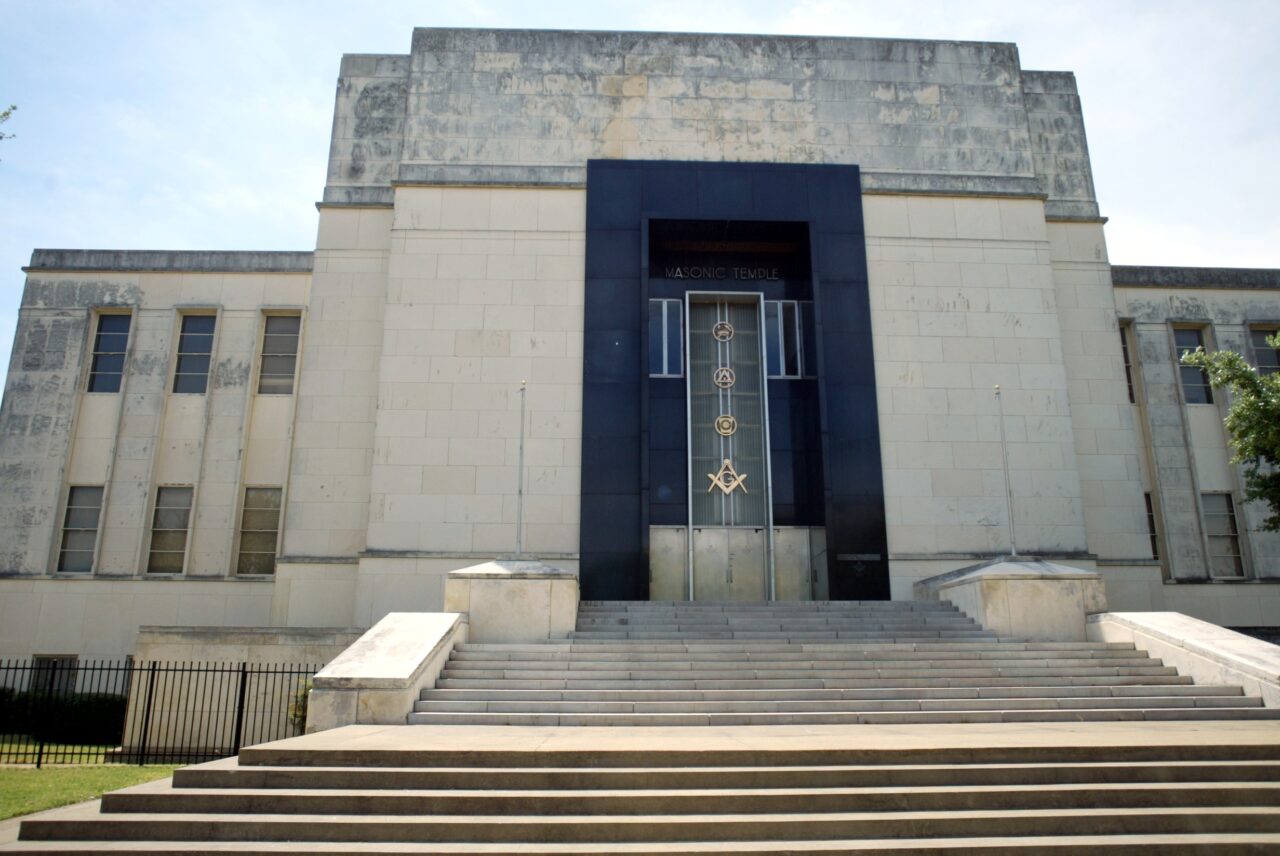
DreadXP: What’s some of the stuff they wouldn’t let you put in there?
Napadano: There’s a lot of things that didn’t make it in there. There was something to do with the end scene, which Merrit thought was too X-rated to put in a computer game, that would mess up the rating or whatever, which had to do with the way Stephanie was… restrained, we’ll say. There was supposed to be something going in and out of her between her legs the whole time, this mechanical device like a piston. That was built and animated but they said no. That’s probably on my Amiga! And Gilbert wanted upper nudity on Stephanie when she was changing, and it was originally supposed to be her mother looking through the hole in the wall. They didn’t want that either, they didn’t want the mom to be looking at her. But it was supposed to be the mom fantasizing about her daughter and looking at her through a hole in the wall… A lot of the stuff that didn’t make it into the game was more graphics than scenarios. The limitations of doing this for Merrit were fairly strict. They were OK with having a shocker game but they didn’t want specific things that would get it a rating where kids wouldn’t play it.
DreadXP: From the research Aarno has done it sounds like the only thing that got cut out in terms of scenarios was being able to burn down the Wasp Woman’s house.
Napadano: Yeah. That and being able to kill my little son, who played the daughter. I made sure of that, that you couldn’t kill him. The Wasp Woman’s house wasn’t cut for reasons of being “bad,” it was cut because it didn’t look good in the game. And there was no real reason to burn down the house and we couldn’t figure out a clever way to do it where it was, ‘that’s cool!” We couldn’t find the “that’s cool” in it. I don’t think anyone was trying to say, “let’s not have arson in the game,” because we totally would’ve put that in. It just didn’t make sense to burn down the house. Gilbert also wanted to see her crawling like a bug, which you wouldn’t really be able to do if you burned down the house.
DreadXP: How many of you were there working on the game?
Napadano: In the beginning it was just me, Tom, and Chad, and then we immediately hired on Tim. I hope they forgive me if I forgot but in it the beginning I think it was just us. Then towards the end of production we got like five or six guys doing different things, mainly mechanical art things. And game testing. There was a lot of kids doing that.
DreadXP: What was the most difficult part of the process?
Napadano: The character movement and combat. That was the tricky part because we had four different ways we wanted to do it and none of them were easy. Time was running out and we had to pick a way. That’s why a lot of the characters, you see their faces but you don’t see their mouths moving. We had other plans for that, and then, running out of time, it was “just stick to faces!” We wanted to film everyone actually doing their lines. A lot of time was spent in front of the green screen at Merrit Studios, where we had a makeshift green screen setup. A lot of it was done out there but we didn’t know at the time we were doing all the green screen shots that we wanted to have the characters move their mouths, we had other plans for that. But the plans never worked out. You know what I mean? Because there were plans to do this, we missed the opportunity to do that.
My infant son played the baby sister. Gilbert wanted to use him so bad, he was basically begging me. I was like “I don’t want my baby in the game and people killing him!” Finally he was, “OK, you can’t kill him,” and I was like fine, you can put him in then!
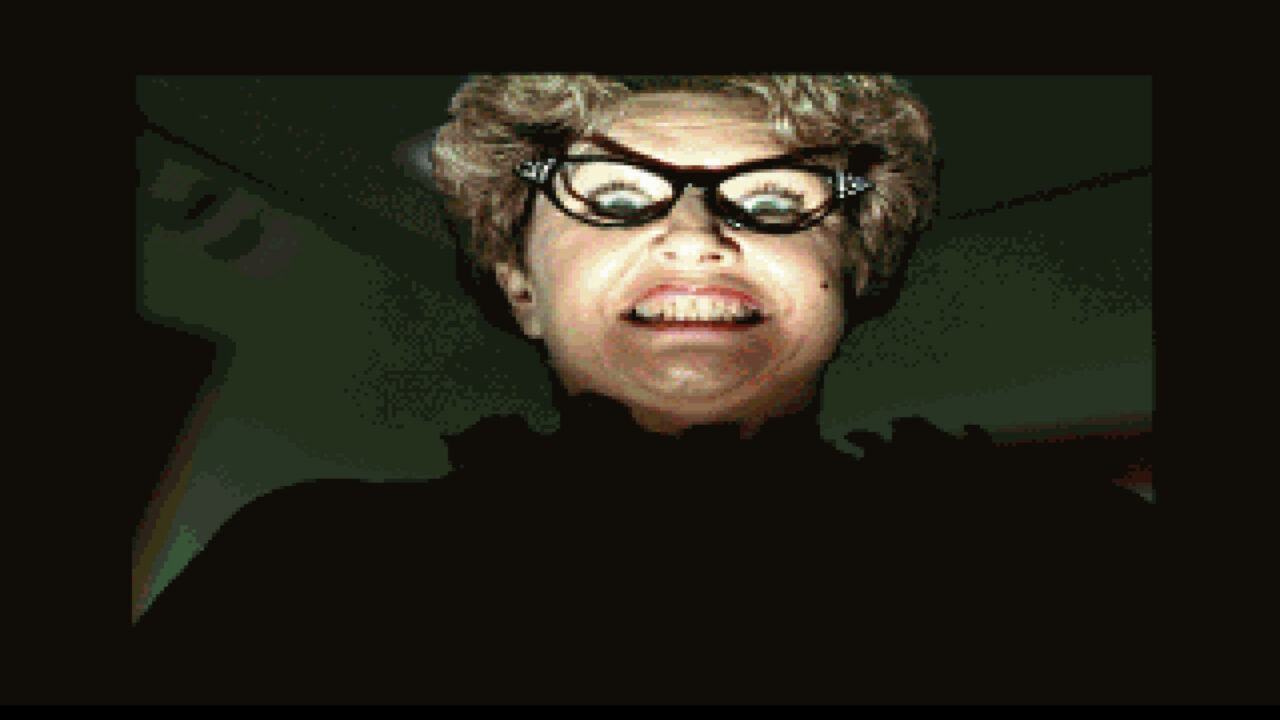
DreadXP: Can we talk about the Lodge section of the game? Harvester takes such a left turn tonally and aesthetically at that point, and really doubles down on the horror content, but of all the making-of content floating around out there, there’s nothing about it.
Napadano: Originally the Lodge was supposed to be like a lodge, like an old Native American lodge, a longhouse sort of thing. We wanted the whole mystique of a secret society. Gilbert wanted that in the game because it’s the best way to describe how they’re creating serial killers secretly. We were both fascinated by The Masons, and we had a lot of stuff brought in—Nick’s dad was a mason. He brought in one of their books, we were going through it and very impressed by some of the weirdness of the whole thing. They even had catalogs, the Masons had catalogues where you could order stuff. We looked at some of those. A lot of the weird Lodge ideas were based on the Masons and secret society stuff.
DreadXP: How did the shift from a longhouse to what we get happen? Now it’s like- for lack of a better phrase- this real mindfuck thing, going through vaginal tunnels and the Roman colosseum, the Korean war room…
Napadano: First things first, when you mention human insides, that was designed to desensitize the person to killing. It’s easier to kill an ugly eyeball coming at you than it is a person. If you’ll notice, in the lodge, there’s different degrees of humanity basically. Starting off with evil, insect-like monsters, it’s easy to slowly break someone down, and desensitize you to being able to murder children. That was Gilbert’s original idea, that’s why these things are so gross at first and then simmer down. You get to the children eating their mother, and– there was something else, a side note to that scene I can’t remember, something Gilbert was setting up with that scene he was going to do something else with it. But that was the sense of the Lodge, desensitizing someone to be able to kill.
DreadXP: Do you have a personal favorite set design?
Napadano: I really like the auditorium where the cowboy show is on, but, I didn’t do that one; I think Chad did the inside of the theater. I’m not really fond of any place in the Lodge. I can talk about what I don’t like! [Laughs] The Lodge was just too out of place. It didn’t look like my vision, or the vision Gilbert was discussing. The interiors were too different; to me, it just fell apart. I couldn’t follow it as easily. It wasn’t realistic enough for me. That would be my least favorite. I was working on almost every shot of the town, the exteriors. One I modeled after my house in Youngstown that I lived in back in the 70s; the guy who owns the Tucker, his house. I have real photographs of that house. But pretty much all the exterior shots I like because it really looks like a real town, somewhat.
I didn’t do all of them; I did the missile base, all the B17s were mine. I did the general store, and then Kevin would go in and take my art and put things on top of it. For instance, the old, faded writing on the bricks that said “Air Conditioning,” he put that in there, and I thought that was awesome. It fit perfectly. Kevin was the real artist in this; he would go over everything and put things in there. He’s also the face of the Sergeant at Arms. I’m the body on the box; he wanted to take the picture so I posed in the robe. But it’s his face.
DreadXP: That’s something I wanted to ask. You really do this great job of creating a town that looks and in a lot of ways feels like a real, off-the-beaten-path, small American town, though with something not quite right about it; and then, smack in the middle of it, the Lodge is based on the Hagia Sophia. Was there a reason behind that?
Napadano: I believe that was Chad’s idea. He misinterpreted the look of what Gilbert wanted, and then when Gilbert saw what he had done, he was, “Oh, no, that’s awesome.” But I don’t think Gilbert was always pleased with how it looked. He was thinking more along the lines of a traditional Freemason Lodge, like the one here in Dallas, that looks like an old government building. Chad’s the one that got all the references. I was working on my own things.
DreadXP: Any favorite set pieces you enjoy particularly, or things you enjoyed working on?
Napadano: There were a lot of things I didn’t like! [Laughs] The Fire Department… Gilbert went way over the top on that one. I do like the fact that the houses were designed like either the 50s or the 70s; most of the houses were based off of places I’d lived before. Steve’s house was a place I’d lived in Springfield, Ohio. I like the houses for that reason, that they all have a basis in my life. I can remember me, Kevin, and Gilbert going to thrift stores looking for silly items we could put in the game, just to make it more weird. I think that was just us being lazy [Laughs]. This was when we’d already done some designs and we had a lot of time to just sit and talk and hang out, mainly because there was only one programmer at the time and Nick had his hands full. We found the Freemason catalogue.
And there used to be a box, it’s in a background shot, they’d vote in Freemason knights by a box of rocks, and there was a black rock and a white rock and they’d put them in this box. We stuck that in the background of one of the scenes; I don’t know if you can even see it now. It was in the Lodge at some point. We found lampshades and things we would stick in. We also wanted to put cats in the game but everybody killed them all; they put them in the damn meat packing factory! But we wanted a cat in every scene. Just like Psych, in every scene, in every episode, there’s a pineapple somewhere. We wanted to do that with cats, but, it never got in there.
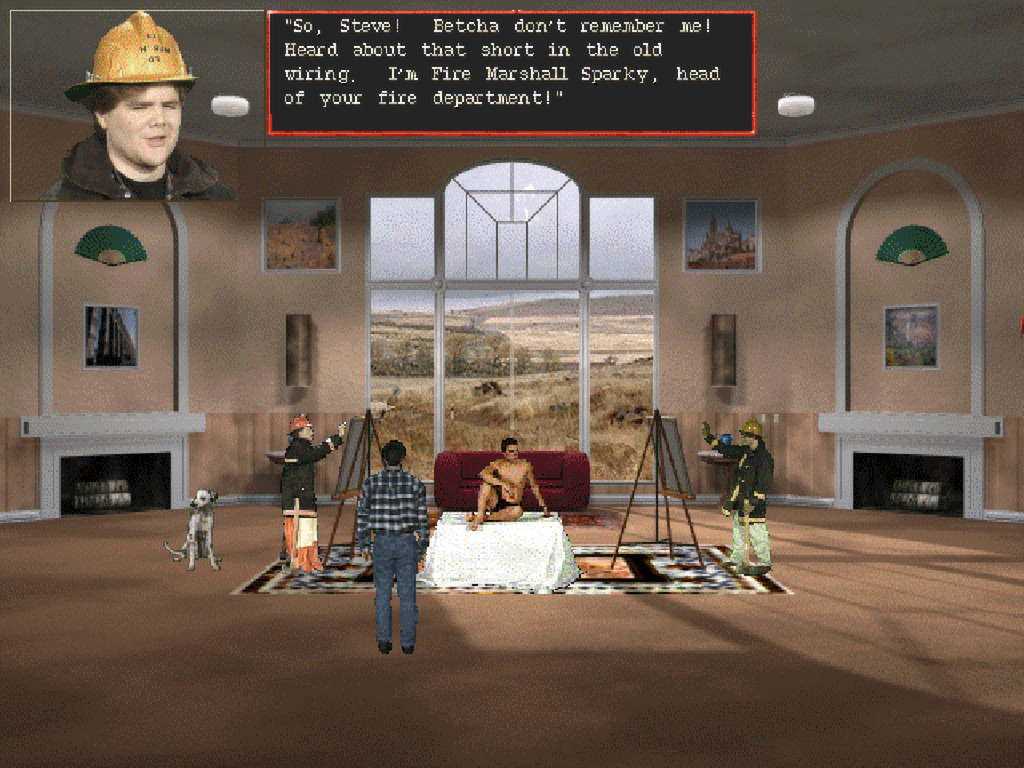
DreadXP: How did Harvester get cast?
Napadano: Ultimately it was Gilbert’s decision but we all had ideas. I wanted Stephanie to look like Madchen Amick. That was the vision both Gilbert and I had for that character, but, she changed eventually. We all sat in on casting. We had a book, it was a SAG catalogue with actors from around Dallas and we would go into meetings and go through them, and Gilbert would circle things, “I want this person for this, this person for this.” We interviewed them all. Only two of them couldn’t do it so we had to choose somebody else. We basically all had say in it; I don’t think Chad or Tom really found it important to deal with it, so they didn’t give it much thought. It was really me, Gilbert, and Kevin.
DreadXP: After Harvester actually dropped, what happened next?
Napadano: It was Sleeptown, USA. It was nothing happening! When Harvester hit the shelves, nothing happened! I had already quit the company weeks before the release. When it was released we all went to the release party, but, we took so long with the game people were pissed off. They were being babies. “Fine, we don’t wanna buy it now!” It did well in Europe. We were impressed by that. We heard a week or month later how well it was doing in the UK and Germany. There was a town in Germany that banned it! One town! We saved the article. One of us has it somewhere. But I’m not sure of the story behind that. Unless Merrit held something back from us, as far as we knew, it wasn’t selling at all.
DreadXP: Did the delay hurt it more than the controversy?
Napadano: Absolutely! That’s the only thing that hurt it! We were competing with Phantasmagoria at the time. Phantasmagoria had a better idea, they were doing the characters one of the ways we were going to do ours, but, a lot of people were just pissed that Phantasmagoria wasn’t going to be as scary and gory as they said it was going to be. Well, our game was as scary and gory as they said Phantasmagoria was going to be, but we didn’t have the character movements they had. But that was our rival game. Controversy should’ve picked up sales. More controversy would’ve been awesome.
We’d like to thank Michael Napadano for taking the time to talk to us about Harvester. If you’re interested in more dives into horror games, check out DreadXP for more.
Categorized:Interviews
